
The entrance to my sit spot
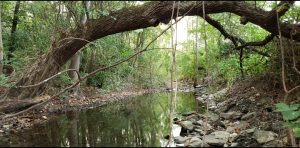
The willow from where I sit where it reaches across the creek to grasp the light necessary for photosynthesis thanks to phototropism
People say that some things get better with age and Hollins certainly has its history as well as its beauties. One such beauty is located behind the lake near the Forest of Arden; to get there to this spot is an adventure itself as you walk through the creek under the willow to the small rocky outcropping.
The things within Hollins are no exception to beauty with age. For example, the observed, iconic willow tree now has a new characteristic in the form of a vine that drapes down from the willow into the creek among other vines that co-exist with the willow along its upper branches, almost as if it is the caretaker of this area. Each of these plants competes for the sunlight thanks to their adaptations, often through phototropism, such as when the trees grow in the direction opposite of the shade, or sometimes on a smaller scale where they change orientation throughout the day.
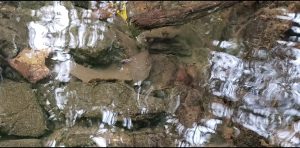
The water strider atop the water, one of the three observed species, that is exhibiting its adaptation to the water by taking advantage of surface tension
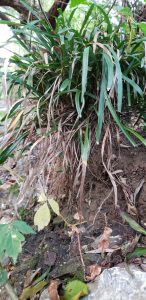
The lilirope grass, also one of the three observed species
As time progressed from the previous encounter with this spot, the water in the creek had risen a few inches, the effects of this change long reaching. The water seemed to give the vines a new life, but at the same time, it took life away from lower-lying plants, like the lilirope grass that now had its roots exposed from the rain. With the main source of nutrients for the plant exposed, the flowers had since died off and the tips of the long leaves followed suit.
Nonetheless, the water was home for some of these creatures, such as the water striders who took advantage through adapting to one water’s many amazing features, surface tension, where they bounce weightlessly across the top of the water, this time not knowing where to go as the sunlight was not there to guide them. Since the light was gone, they no longer grouped together like last time and appear to be socially distancing themselves from each other. Other aquatic creatures, like fish that called the deeper parts of the water home, also learned to adapt to the water through having a swim bladder allowing them to seamlessly swim to whatever depth they wish.
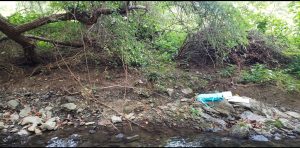
East Bank where the soil had eroded into a steep hillside
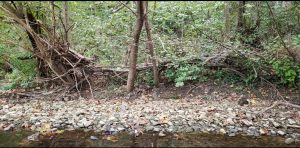
West Bank where the branches got swept into the trees from the water
The water not only had influence over the flora and fauna, but the landscape itself was shaped by the water. On each side of the creek, new piles of sticks that had been pushed towards the creek were trapped by the trees along the west bank. The edges of the bank were sloped from the long term erosion of the soil from the rise and fall of the water.
Upon the long-awaited exploration, upstream of the spot, the water deepens to a whole different kind of environment filled with darting fish rather than calm crawfish and water striders. Meanwhile, the downstream speeds up the water as the slope increases revealing little life within this rough area. With each step, a trail of sediment followed making the water cloudy. These kinds of environments the water creates are demonstrated even further after discovering a stagnant pond behind the west bank. This pond was stagnant with the whisps of iridescent glaze over its surface only home to decaying leaves and runoff.
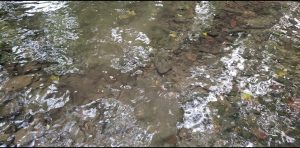
The muddied stream water from my footsteps
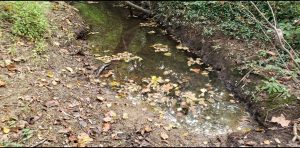
The stagnant pond behind west bank

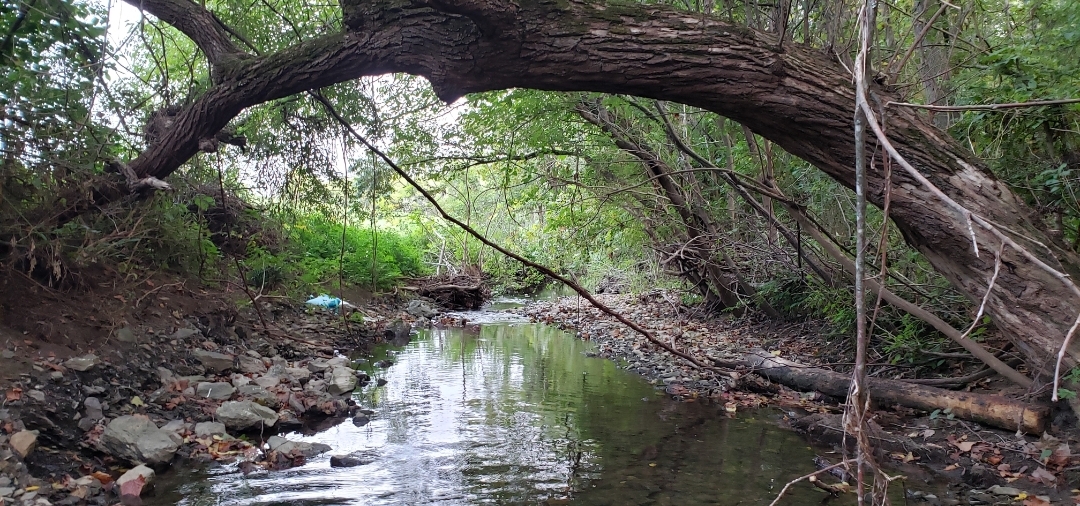
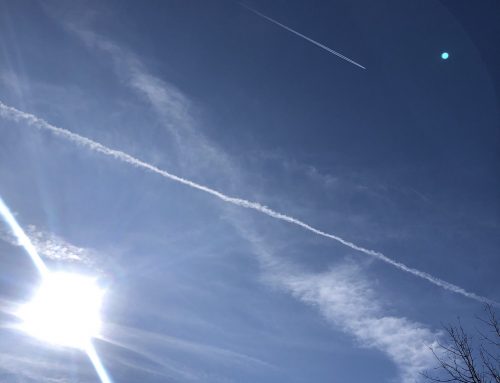
I really love your writing style-it was a great blog! Your spot is very pretty and I’m interested to see how the water effects the spot as seasons change. I really liked your pictures-your spot looks great!
Hi Kylie! I absolutely loved reading about your sit-spot and the changes in the water effects and the natural landscape that you notices. I love your writing-style as it contains several pieces of descriptive analysis and thoughtful remarks. I found it very interesting that you were able to notice these specific changes and adaptations within your sit-spot. The pictures you included as well as your meaningful descriptions allowed for me to clearly visualize your sit-spot. Your word choices are very fitting as well to your very lively surrounding environment. I think that it was fascinating to see how these changes allowed for certain adaptations to occur within your sit-spot. I would love to hear more about the specific things you examined from an outside perspective as for how the three things you noticed changed or stayed the same. Can you predict any changes that you think some species might exhibit as the seasons change? I really enjoyed your strategic phrasing and illustrations in addition to the specific changes in adaptations you noticed.